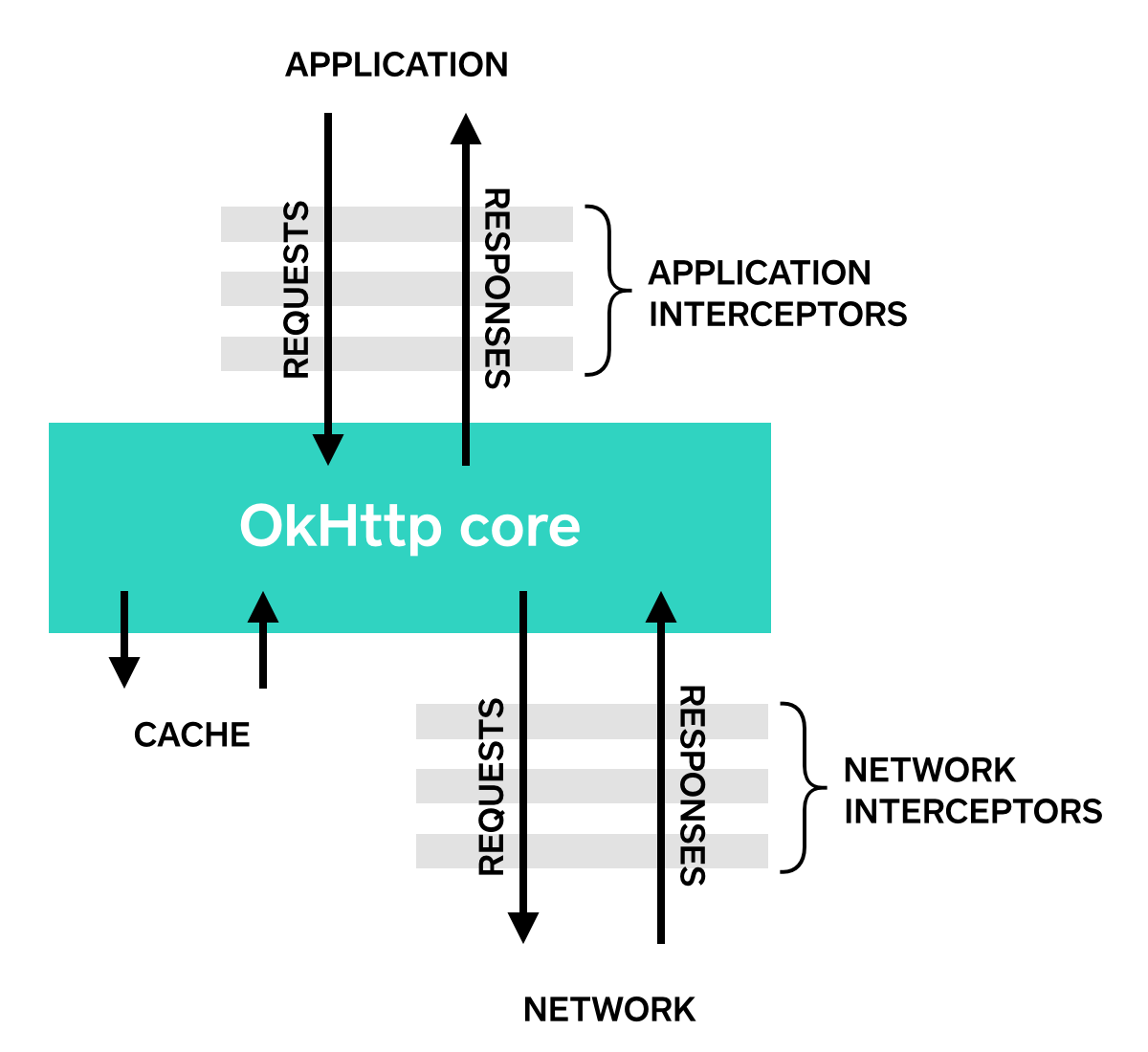拦截器是一种强大的机制,可以监视、重写和重试调用(Call)。下面是一个简单的拦截器,它记录发出的请求和传入的响应。
class LoggingInterceptor implements Interceptor {
@Override public Response intercept(Interceptor.Chain chain) throws IOException {
Request request = chain.request();
long t1 = System.nanoTime();
logger.info(String.format("Sending request %s on %s%n%s",
request.url(), chain.connection(), request.headers()));
Response response = chain.proceed(request);
long t2 = System.nanoTime();
logger.info(String.format("Received response for %s in %.1fms%n%s",
response.request().url(), (t2 - t1) / 1e6d, response.headers()));
return response;
}
}对chain.proceed(request)的调用(Call)是每个拦截器实现的关键部分。这个看起来简单的方法是所有HTTP工作发生的地方,生成响应以响应请求。
拦截器可以链接起来。假设您有一个压缩拦截器和一个计数拦截器:您需要决定数据是压缩后再进行计数,还是计数后再进行压缩。OkHttp使用列表跟踪拦截器,并按顺序调用拦截器。

应用程序拦截器
拦截器可以注册为应用程序拦截器或网络拦截器。我们将使用上面定义的LoggingInterceptor来显示区别。
注册一个应用拦截器通过在在OkHttpClient.Builder调用addInterceptor()。
OkHttpClient client = new OkHttpClient.Builder()
.addInterceptor(new LoggingInterceptor())
.build();
Request request = new Request.Builder()
.url("http://www.publicobject.com/helloworld.txt")
.header("User-Agent", "OkHttp Example")
.build();
Response response = client.newCall(request).execute();
response.body().close();URL http://www.publicobject.com/helloworld.txt重定向到https://publicobject.com/helloworld.txt,并且OkHttp自动跟随这个重定向。我们的应用程序拦截器调用一次,然后从chain.proceed()返回重定向后响应:
INFO: Sending request http://www.publicobject.com/helloworld.txt on null
User-Agent: OkHttp Example
INFO: Received response for https://publicobject.com/helloworld.txt in 1179.7ms
Server: nginx/1.4.6 (Ubuntu)
Content-Type: text/plain
Content-Length: 1759
Connection: keep-alive我们可以看到我们被重定向了,因为response.request().url()与request.url()不同。两个日志语句记录两个不同的url。
网络拦截器
注册网络拦截器非常类似。调用addNetworkInterceptor()而不是addInterceptor():
OkHttpClient client = new OkHttpClient.Builder()
.addNetworkInterceptor(new LoggingInterceptor())
.build();
Request request = new Request.Builder()
.url("http://www.publicobject.com/helloworld.txt")
.header("User-Agent", "OkHttp Example")
.build();
Response response = client.newCall(request).execute();
response.body().close();当我们运行这段代码时,拦截器会运行两次。第一次是请求http://www.publicobject.com/helloworld.txt,第二次是重定向到https://publicobject.com/helloworld.txt。
INFO: Sending request http://www.publicobject.com/helloworld.txt on Connection{www.publicobject.com:80, proxy=DIRECT hostAddress=54.187.32.157 cipherSuite=none protocol=http/1.1}
User-Agent: OkHttp Example
Host: www.publicobject.com
Connection: Keep-Alive
Accept-Encoding: gzip
INFO: Received response for http://www.publicobject.com/helloworld.txt in 115.6ms
Server: nginx/1.4.6 (Ubuntu)
Content-Type: text/html
Content-Length: 193
Connection: keep-alive
Location: https://publicobject.com/helloworld.txt
INFO: Sending request https://publicobject.com/helloworld.txt on Connection{publicobject.com:443, proxy=DIRECT hostAddress=54.187.32.157 cipherSuite=TLS_ECDHE_RSA_WITH_AES_256_CBC_SHA protocol=http/1.1}
User-Agent: OkHttp Example
Host: publicobject.com
Connection: Keep-Alive
Accept-Encoding: gzip
INFO: Received response for https://publicobject.com/helloworld.txt in 80.9ms
Server: nginx/1.4.6 (Ubuntu)
Content-Type: text/plain
Content-Length: 1759
Connection: keep-alive网络请求还包含更多的数据,比如Accept-Encoding:由OkHttp添加的gzip头来声明对响应压缩的支持。网络拦截器的链具有非空连接,可用于查询用于连接到web服务器的IP地址和TLS配置。
在选择应用程序拦截器和网络拦截器之间选择时,每个拦截链都有相对的优点。
应用程序拦截器
- 不需要担心中间响应,比如重定向和重试。
- 总是调用一次,即使从缓存中提供HTTP响应。
- 观察应用程序的原始意图。不关心像If-None-Match这样的okhttp注入header。
- 允许短路和不调用Chain.proceed()。
- 允许重试并对Chain.proceed()进行多次调用。
网络拦截器
- 能够操作中间响应,如重定向和重试。
- 不因调用缓存的响应使网络短路。
- 观察数据,就像它将通过网络传输一样。
- 访问承载请求的连接。
重写请求
拦截器可以添加、删除或替换请求header。它们还可以转换具有一个请求的主体(body)。例如,如果您连接到一个已知支持它的web服务器,您可以使用一个应用程序拦截器来添加请求体压缩。
/** This interceptor compresses the HTTP request body. Many webservers can't handle this! */
final class GzipRequestInterceptor implements Interceptor {
@Override public Response intercept(Interceptor.Chain chain) throws IOException {
Request originalRequest = chain.request();
if (originalRequest.body() == null || originalRequest.header("Content-Encoding") != null) {
return chain.proceed(originalRequest);
}
Request compressedRequest = originalRequest.newBuilder()
.header("Content-Encoding", "gzip")
.method(originalRequest.method(), gzip(originalRequest.body()))
.build();
return chain.proceed(compressedRequest);
}
private RequestBody gzip(final RequestBody body) {
return new RequestBody() {
@Override public MediaType contentType() {
return body.contentType();
}
@Override public long contentLength() {
return -1; // We don't know the compressed length in advance!
}
@Override public void writeTo(BufferedSink sink) throws IOException {
BufferedSink gzipSink = Okio.buffer(new GzipSink(sink));
body.writeTo(gzipSink);
gzipSink.close();
}
};
}
}重写响应
除了重写请求,拦截器可以重写响应header并转换响应主体。这通常比重写请求header更危险,因为它可能违反web服务器的预期!
如果您处于一种棘手的情况,并且准备好处理后果,那么重写响应header是解决问题的一种有效方法。例如,您可以修复服务器配置错误的Cache-Control响应header,以启用更好的响应缓存:
/** Dangerous interceptor that rewrites the server's cache-control header. */
private static final Interceptor REWRITE_CACHE_CONTROL_INTERCEPTOR = new Interceptor() {
@Override public Response intercept(Interceptor.Chain chain) throws IOException {
Response originalResponse = chain.proceed(chain.request());
return originalResponse.newBuilder()
.header("Cache-Control", "max-age=60")
.build();
}
};通常这种方法在对webserver上的相应修复进行补充时效果最好。
可用性
OkHttp的拦截器需要OkHttp 2.2或更高版本。不幸的是,与OkUrlFactory拦截器不匹配,或基于OkUrlFactory的库的构建,包括Retrofit≤1.8和Picasso≤2.4。
本文是翻译文章:原文地址:https://github.com/square/okhttp/wiki/Interceptors